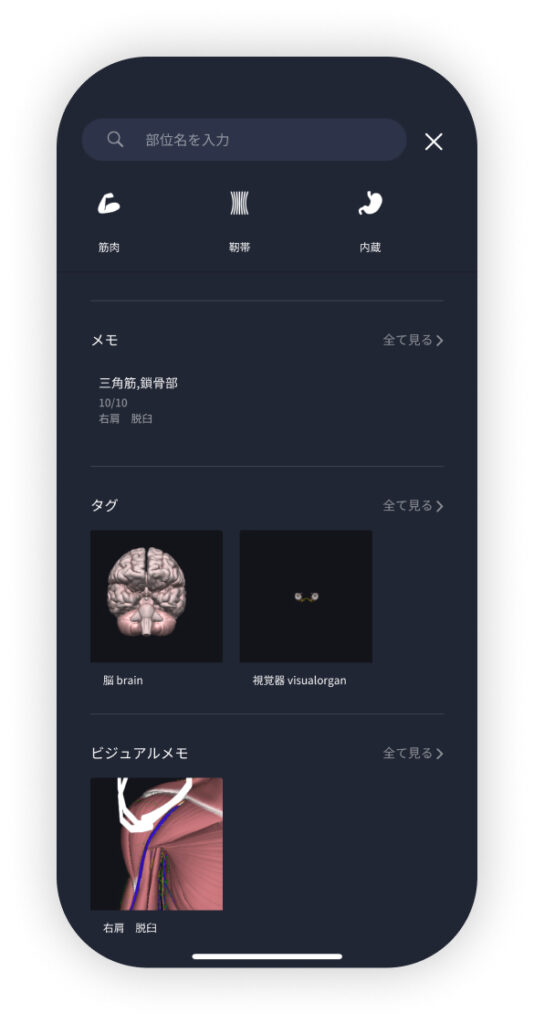beginning
In this article, I will explain effective study methods, starting with knowledge of specialized parts in human anatomy.
In human anatomy, it is necessary not only to memorize the names of various organs, muscles, and bones, but also to remember where they are located in the body. Therefore, it is necessary to learn as efficiently as possible.
I hope you can read this article and use the app to deepen your understanding even a little bit.
Now, I'll explain the details about the “sciatic nerve” and how to study human anatomy.
teamLab Body Pro Free Download
A 3D anatomy app that shows all the structures of the human body
Download teamLab Body Pro here!

What is the sciatic nerve?
In the anatomy application, you can view a selection of anatomy 3D models. In this model, there are various observation methods such as surfaces, cross-sections, and nervous systems. This time, I'll explain using an anatomy application.
About sciatic nerve

The sciatic nerve is the largest nerve in the human nervous system. This nerve starts in the lower back, passes through the buttocks, and extends through the back of both legs to the bottom of the foot. The sciatic nerve plays an important role in transmitting sensation to the muscles and skin in the lower body part of the body. Generally, by staying in the same position for a long time or taking an unreasonable position, the sciatic nerve may be compressed and cause pain or numbness. This is called sciatica. In everyday life, when you feel sudden pain in your lower back or leg, sciatica may be considered as one of the causes. This pain can spread from the buttocks to the back of the thighs, and sometimes to the toes. The degree of pain varies from person to person and ranges from mild discomfort to severe pain. To prevent sciatica, it is recommended to avoid staying in the same position for long periods of time and to incorporate moderate stretching and exercise. In addition, exercises to prevent back pain, posture improvement, and proper rest are also effective. If symptoms of sciatica persist, it's important to seek the opinion of a healthcare professional. It is important to get the right treatment if needed, based on the specialist's diagnosis.
Study points
The location and structure of the sciatic nerve
The sciatic nerve is the longest and widest nerve in the human body, and extends from the lower back to the foot. This nerve originates from the lumbosacral plexus, runs from the lower back through the pelvis, and extends along the back of both legs via the buttocks. The sciatic nerve starts at the lower part of the lower back, specifically the lumbar spine and sacrum, passes under the buttocks muscle called piriformis muscle, and runs over the back of the thigh to reach the back of the knee. From there, it branches further outward, and is divided into the fibular nerve and the tibial nerve behind the knee, and each extends to the calves and legs. As a structure, the sciatic nerve roots that come out of the spinal cord gather and form a large, thick nerve bundle in the pelvis. This nerve is derived from a nerve network called the lumbosacral plexus, and the lumbosacral nerve roots from L4 to S3 are combined into one powerful bundle, and electrical signals are transmitted to the foot through the sciatic bone. These signals convey information that controls muscle movement and sensory information from the lower extremities. The sciatic nerve divides into two at the back of the knee, into the tibial nerve and the fibular nerve. This transmits signals to various parts of the legs and feet, particularly the calves and toes. Damage or compression of the sciatic nerve causes sciatica, leading to pain and numbness from the lower back to the legs. This is usually due to a herniated disc or spinal misalignment. Proper diagnosis and treatment is needed, so it is important to see a doctor.
The role and function of the sciatic nerve
The sciatic nerve is the longest and thickest nerve in the human body, and is one of the most important peripheral nerves running from the lower back to the foot. This nerve starts in the lumbar spine (spine), passes through the pelvis, passes through the sciatic foramen (sciatic foramen), passes through the back of the leg, and continues to the back of the knee. Then, it runs on the back of the knee, divided into the common fibula (fibular) nerve and the tibial (spasmodic) nerve. The sciatic nerve mainly plays the following roles. First, it plays a role in sensory transmission. The sciatic nerve is the longest and thickest peripheral nerve in the human body, and transmits sensory information from the legs and feet to the brain by sending nerve signals from the lower back of the foot. This allows you to feel the feel of something you touch, pain, heat, or cold. Next is motor nerve transmission. The sciatic nerve transmits commands to the muscles of the legs and lower body to be active, enabling movements such as walking, running, and jumping. This enables smooth and effective body movement by correctly transmitting signals from the brain to the muscles. Finally, let's talk about maintaining body stability. The sciatic nerve plays an important role in maintaining posture stability and balance by controlling lower body muscles. It plays a particularly important role while walking, running, and jumping. Sciatica is often caused by the sciatic nerve being compressed or irritated. This can cause pain from the lower back to the legs, and sometimes lead to weakness. For this reason, it is important to pay attention to sciatic nerve health.
English notation for sciatic nerve
The word “sciatic nerve” is expressed as “sciatic nerve” in English. The sciatic nerve is the longest and thickest nerve in the human body, and extends from the spinal cord to the lower extremities. This nerve starts at the lower back, extends through the buttocks to the legs, and plays an important role in covering the legs and feet. The sciatic nerve comes out of the back of the pelvis in the buttocks, passes through the back of the thigh, divides forked behind the knee, and follows a path extending to the lower leg, and is involved in sensory and motor function of the lower limbs. In English, this sciatic nerve is called the “sciatic nerve (sciatic nerve).” The word “sciatic” has the meaning of “sciatic,” and is commonly used as an English expression related to the sciatic nerve. Sciatica is called “sciatica (sciatica),” and it indicates a condition that causes pain or numbness from the buttocks to the legs. The main causes of sciatica include herniated discs, lumbar spondylolisthesis, spinal canal stenosis, etc., and these often cause pain by compressing nerves. Also, if you continue to sit in an unreasonable position or for a long time in your daily life, your sciatic nerve will be strained, and symptoms may worsen. With proper treatment and rehabilitation, it is possible to reduce pain and improve the quality of daily life. In addition, regular stretching and exercise, and maintaining proper posture can also help prevent it.
How to study human anatomy
I will explain specific study methods using human anatomy applications.
Check your past learning history and practice repeatedly
Here are the steps to check your anatomy learning history and practice iteratively effectively.
1. Check your learning history in the app
Reviewing your learning history with the application is an important step in effectively advancing anatomy learning. First, launch the app and go to the learning history section from the main menu. Many anatomy apps are designed to show your progress in the form of graphs and lists, so you can visually check which parts you've learned about and how much time you've spent.
By using this data, you can understand which areas you have strengths in and where you need to spend more time and effort. We also recommend using a dedicated tag or notebook function to mark areas you are particularly weak at or where you need to relearn. Regularly checking your learning history and looking back on past learning content will lead to efficient review and deepening understanding.
2.Make a plan for iterative learning
Making an efficient repetitive learning plan based on learning history is extremely effective in promoting knowledge retention. First, identify weak points and areas where you need to relearn. Next, arrange these study items into a weekly or monthly calendar and create a specific study schedule. By proceeding in a planned manner, you can learn each part evenly and avoid packing in a large amount of information at once.
Using a task management app or digital calendar to set study reminders is effective. Also, it's important to have the flexibility to regularly review progress and revise plans as needed. By having goals and proceeding with your studies in a planned manner, you can efficiently acquire anatomical knowledge.
3.Use 3D features to learn visually
By utilizing the 3D function, learning anatomy is easier to understand visually. The 3D model shows the structure of the human body three-dimensionally, and each part can be observed in detail. This makes it possible to intuitively grasp positional relationships between deep muscles and organs that are difficult to capture in a planar view. For example, you can learn even the smallest details by rotating specific muscles and bones and zooming in and out.
Also, there are many apps that have the function of displaying cross-sectional views of each part using a 3D model, which is useful for deepening understanding of internal structures. This diversity of visual information helps with memory retention and improves immediate responsiveness in tests and practice situations. By utilizing the 3D function and learning visually, you can learn anatomy knowledge more deeply and efficiently.
Use the memo function concretely

Make notes so you don't forget the things and points you've noticed while studying. The memo function can be used for different purposes, such as inputting text, saving images, and writing memos. Tag your notes to make them easier to review later.
Test your learning regularly in the form of quizzes
Regularly testing what you've learned in a quiz format is a very effective way to anchor your anatomy knowledge. Quiz-style tests help you objectively grasp your level of understanding and areas you lack while repeating knowledge.
For example, by using a learning app to conduct quizzes every specific period, you can reconfirm what you've learned and strengthen your memory. There are a wide range of quiz formats, such as multiple choice questions, fill-in-the-blank questions, and short answer questions, and each helps understanding from a different angle and develops the ability to utilize various types of knowledge.
Get feedback
If possible, get feedback from other learners and experts. It helps you find your own gaps in understanding and areas for improvement. You can also keep yourself motivated to learn by regularly testing yourself. Feeling a sense of accomplishment and progress increases motivation for continuous learning.
summary
This time, I explained how to study the “sciatic nerve” using an application!
Thank you for reading this far.
I would be happy if reading this article helped you learn about anatomy.
Learning is a long, never-ending journey, but I sincerely wish you all the best. Let's continue to study together and work hard for the national exam!
Please look forward to the next blog.




